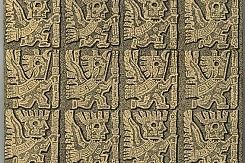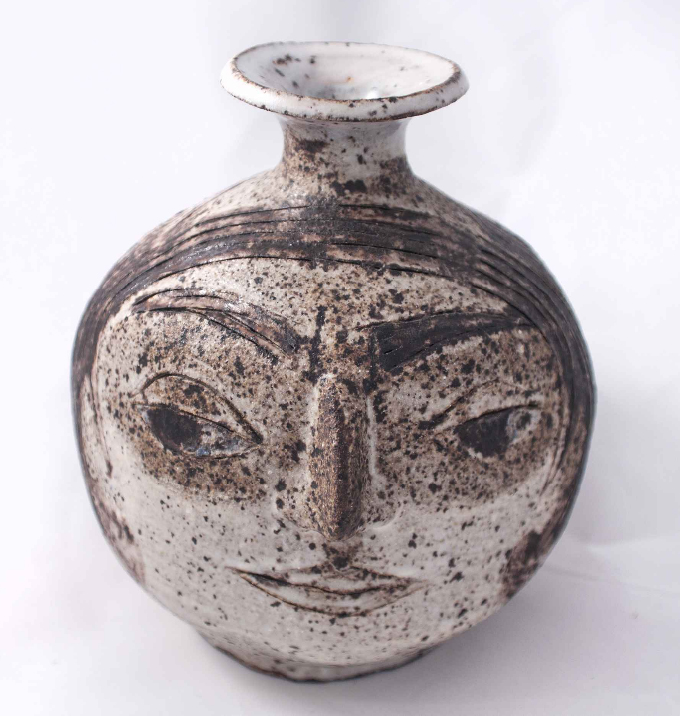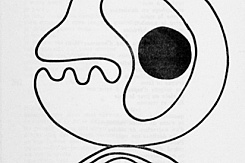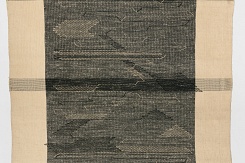Video
Reading Sibyl Moholy-Nagy, Native Genius in Anonymous Architecture in North America, 1957
Center For Postcolonial Knowledge and Culture, Berlin (CPKC)
Reading Sybil Moholy-Nagy, Native Genius in Anonymous Architecture in North America, 1957
Silke Briel (Camera), Jonas von Lenthe (Production Manager), Marion von Osten (Director), Jill Winder (Actor), Text quotes by Hilde Heynen.
In the 1960s, the interest in a regional and vernacular architecture evolved into a sort of counterculture against the prevailing modernism in the USA. Sibyl Moholy-Nagy’s book is an early document of this movement and today a classic of architecture history. It features buildings and construction techniques that emerge from social practices and whose builders remain anonymous. They include Amerindian settlement forms, Mexican pueblos and churches, as well as barns and houses of the first European settlers. The book highlights cultural and social needs as well as political and climatic conditions that lead to different building methods, The publication is the result of several field research trips taken between 1948 and 1952 to structures that were hitherto not subjects taught at American universities because they were deemed banal. In her study, Moholy-Nagy focuses on local buildings in North and Central America, but also shows anonymous buildings and details of the German Baroque period and the Middle Ages. She argues that popular American architecture was more direct and did not adhere to specific styles, thus criticizing a Euro-American history of architecture that until then had only taken ruling-class architecture, styles or famous architects into account. However, the book does not develop a critical vocabulary with regard to settler colonialism, instead adopting anthropological methods informed by structuralism. After the death of her husband, Moholy-Nagy taught architecture history at the IIT Chicago, the University of California in Berkeley and later the Pratt Institute New York.
Center For Postcolonial Knowledge and Culture, Berlin (CPKC)
Common Threads — Approaches to Paul Klee’s Carpet of 1927
Sarah McGavran
Paul Klee’s Carpet, 1927, creates a conundrum for scholars as it does not neatly fit the existing theoretical models concerning how European artists engage with non-Western art and culture, while at the same time opening up exciting new avenues for inquiry. → more
Jun. 10 2018
Paul Klees bildnerische Webarchitekturen
Fabienne Eggelhöfer
Für die Entwicklung seiner abstrakten Bildsprache und seines Bauhaus-Unterrichtes bediente sich Paul Klee unterschiedlicher Quellen, die er im Alltag, auf seinen Reisen oder in Büchern entdeckte. Das Studium nicht-europäischen Designs von Gebäuden und Stoffen, die Fantasiearchitektur der aus Tunesien mitgebrachten Aquarelle oder die auf Papier entworfenen Stoffmuster der Weberinnen bildeten die Grundlage für Werke wie Teppich, 1927, 48. → more
Apr. 8 2019
Weltkunstbücher der 1920er-Jahre — Zur Ambivalenz eines publizistischen Aufbruchs
Susanne Leeb
Um 1900 erschienen die ersten Kompendien und Handbücher über sogenannte Weltkunst. Nach dem Ersten Weltkrieg explodierte dann die Anzahl der Publikationen über außereuropäische Künste. Diese fanden auch sogleich Eingang in die 1919 neu etablierte Bauhaus-Bibliothek. Diese Buchreihen lassen erkennen, unter welchen Bedingungen nichteuropäische Kunst in den 1920er-Jahren rezipiert wurde: als Inspirationsmaterial, als Ausdruck der Kanonkritik an einer europäischen Hochkunst und als Plädoyer für die Aufhebung zwischen Kunst und Kunsthandwerk, aber vor allem auch welches Verständnis von „Welt“ hier reproduziert wurde. → more
Sep. 13 2019
Dry Time — Anni Albers Weaving the Threads of the Past
Maria Stavrinaki
When the Bauhaus was formed it was meant to be the reversed image of contemporary history and society. If the outside world was a field where opposing forces, in the form of class and national struggles, raged, the Bauhaus aimed to extricate itself from these conflicts in order to establish an alternative primordial community. In this essay, Maria Stavrinaki comments on what seems to be Anni Albers’s problematic relationship to the past in general and to history in particular. Anni Albers is not a unique case though, but rather a case study, which despite its particularities, can be considered as analogical to the Bauhaus in general. → more
Apr. 2 2020
Working From Where We Are — Anni Albers’ and Alex Reed’s Jewelry Collection
Brenda Danilowitz
Not by nature acquisitive and certainly not art collectors, Josef and Anni Albers began in 1936 to collect Mexican figurines and other artifacts unearthed from that land’s memory. They described the country, which they first visited in 1935, as “the promised land of abstract art.” Returning to Black Mountain College Anni Albers and Alexander Reed began experimenting with everyday articles to create a strange and beautiful collection of objects of personal adornment inspired by their visit to Mexico. → more
Dec. 11 2018
Andean Weaving and the Appropriation of the Ancient Past in Modern Fiber Art
Elissa Auther
Ancient and Indigenous textile cultures of the Americas played a critical role in the development of the work of fiber artists who came of age in the U.S. in the late 1950s and 1960s. Anyone who has studied fiber art of this period, myself included, knows this well. They openly professed an admiration for traditions ranging from Navaho weaving, to the use of the backstrap loom in Mexico and Central America, to the ancient weaving techniques of Peru. → more
Jun. 8 2018
Anni Albers and Ancient American Textiles
Virginia Gardner Troy
At the time Anni Albers wrote On Weaving in 1965, few discussions of Andean textiles “as art” had appeared in weaving textbooks, but there were numerous publications, many of which were German books published between 1880 and 1929, that documented and described their visual and technical properties. Albers almost single-handedly introduced weaving students to this ancient textile art through her writing and her artistic work. → more
Jun. 7 2018
Josef Albers and the Pre-Columbian Artisan
Joaquín Barriendos
In his inaugural manifesto for the Staatliche Bauhaus, Walter Gropius proposed a new artistic agenda and pedagogical practice based on craft and artisanal principles. This article analyzes how prominent Bauhaus teacher and artist Josef Albers, entered into dialogue with a very specific kind of artisanal aesthetic: the pre-Columbian crafts he encountered on his many trips to Mexico. Revisiting his lecture “Truthfulness in Art” delivered in 1937, after his third trip to the country, the article studies the way in which Albers learned from the abstract tradition of pre-Columbian artisans, incorporating their knowledge into his own artistic and pedagogical practice. → more
Feb. 3 2020
“Every Moment Is a Moment of Learning“ — Lenore Tawney. New Bauhaus and Amerindian Impulses
Mona Schieren
“I felt as if I had made a step and maybe a new form. These evolved from a study of Peruvian techniques, out of twining and twisting. Out of that came my new way of working, of dividing and separating the piece.” Lenore Tawney’s “Woven Forms” are not purpose-built in a (Western) crafts sense; they move beyond traditional European rules of weaving and attempt to approach an indigenous attitude towards craft and technique. This essay shows how Tawney charted her own unique path in fiber art by linking Amerindian impulses with Taoist concepts of space and Bauhaus ideas. → more
Nov. 14 2018
Questions about Lenore Tawney — An Interview with Kathleen Nugent Mangan, Executive Director of the Lenore G. Tawney Foundation
Kathleen Nugent Mangan, Erin Alexa Freedman
The search for the spiritual characterized Lenore Tawney’s long life, and was reflected in both the iconography and materials she used in her work. She was a regular diarist and her journals provide valuable insight into this deeply personal search. bauhaus imaginista researcher Erin Freedman interviews Executive Director of the Lenore G. Tawney Foundation, Kathleen Nugent Mangan, about Tawney’s approach and work. → more
Mar. 10 2019
kNOT a QUIPU — An Interview with Cecilia Vicuña
Cecilia Vicuña, Sabrina Gschwandtner
In this recorded interview, Vicuña describes how after she first learned about quipu, she immediately integrated the system into her life. Quipu, the Spanish transliteration of the word for “knot” in Cusco Quechua, is a system of colored, spun and plied or waxed threads or strings made from cotton or camelid fiber. They were used by the Inca people for a variety of administrative purposes, mainly record-keeping, and also for other ends that have now been lost to history. → more
Aug. 3 2018
Diagonal. Pointé. Carré — Goodbye Bauhaus? Otti Berger’s Designs for Wohnbedarf AG Zurich
Judith Raum
Gunta Stölzl. Anni Albers. These are the most prominent names today when one thinks of actors in the Bauhaus textile workshop. Both had been involved in the textile workshop since Weimar times, shaping it through their understanding of textiles and their teaching. Otti Berger did not join the workshop until Dessau. Stölzl and Albers succeeded in leaving Germany in 1931–32. And they succeeded in continuing to work as textile designers and artists. Berger succeeded in doing this, too, but accompanied by an ongoing struggle for recognition and fair remuneration. → more
Feb. 12 2019
The World in the Province from the Province to the World — Bauhaus Ceramics in an International Context
Hans-Peter Jakobson
In this article Hans-Peter Jakobson presents the various influences, both national and international, and direct and indirect, influencing the views on ceramics taught in the Ceramic Workshop of the State Bauhaus Weimar Dornburg. Based on the life paths, inspirations and influences of the few ceramists who emerged from the Bauhaus workshop in Dornburg, he traces possible worldwide developments in ceramics to the present day. → more
May. 27 2019
Vernacular Architecture and the Uses of the Past
Hilde Heynen
In sending out the manuscript of Native Genius in Anonymous Architecture to a publisher, Sibyl Moholy-Nagy added a note on the “Genesis of the manuscript,” which is quite revealing about the intellectual trajectory that gave rise to it. She positioned herself as first and foremost a traveling observer, learning from direct contact with artefacts and buildings, curious about their histories and willing to interpret material evidence and local narratives. → more
Jan. 11 2019
The “Workshop for Popular Graphic Art” in Mexico — Bauhaus Travels to America
Karoline Noack
The global developments that led in 1942 to the appointment of Hannes Meyer, second Bauhaus director, as head of the workshop for popular graphic art, Taller de Gráfica Popular (henceforth referred to as the TGP), made it a focal point for migrating Europeans in flight from fascism. This essay aims to shed light on how the TGP was influenced by Europeans granted asylum by Mexico before and during World War Two, and, conversely, to explore the degree to which these exiled visual artists, writers, and architects’ ideas came to be influenced by their contact with artists active in the TGP. → more
Oct. 19 2018
Lena Bergner — From the Bauhaus to Mexico
Viridiana Zavala Rivera, María Montserrat Farías Barba, Marco Santiago Mondragón
The story of Lena Bergner is relevant to the history of architecture and design on account of her career passing through different ideological and cultural contexts. Here we will discuss her life and work, focusing on her training in the Bauhaus, her time in the USSR and her time in Mexico, where, along with her husband the architect Hannes Meyer, over a ten-year period she undertook cultural projects of great importance. → more
Oct. 19 2018
Of Art and Politics — Hannes Meyer and the Workshop of Popular Graphics
Raquel Franklin
The Mexico of President Lázaro Cárdenas del Río was a fertile ground for the development of ideological questions, especially those originating from the left. The expropriation of oil fields, mining and large estates in 1938, the refuge granted Spanish republicans and members of the International Brigades in 1939, and the accord of mutual support between the government and syndicalist organizations all favored the formation of artistic and cultural groups willing to take part in the consolidation of revolutionary ideals which, until that point, had made little progress. Among these organizations was the Taller de Gráfica Popular, the Workshop of Popular Graphics. → more
Nov. 20 2018
bauhaus imaginista — and the importance of transculturality
Toni Maraini
What bauhaus imaginista has documented thus relates to a particular historical phase, one that opened a path to the renewal of the art situation in Morocco. And yet, although more recent generations of Moroccan art historians and critics often mentioned the period as a formative and unavoidable reference point, they never really deepened study of that period. It somehow remained in the shadows of other phases and realities. But cultural memory has its rhythms, and the moment arose when the years of the Casablanca Group called for attention, demanding its artistic accomplishments be better understood. In this regard, the bauhaus imaginista project came at the right moment and has had important repercussions. → more
Apr. 21 2020
I was sixteen years old when I undertook my first journey into finding a professional vocation, first in Asilah, then in Fez followed by Tétouan. 1952. Tangiers was, to me, an open book, a window on the world. The freedom of seeing, of discovering and of feeling, of weaving the narratives of my dreams. → more
Mar. 27 2018
The Bauhaus and Morocco
Toni Maraini
In the years when Western nations were committed in new projects of partnership, with what was then called the “Third World”, young artists and students from the Maghreb had grown up in the passionate climate of the struggle for independence, were talented, open to modernity, and eager to connect with twentieth-century international art movements, which were different in production and spirit from colonial ideology and culture. → more
Apr. 3 2018
École des Beaux-Arts de Casablanca (1964–1970) — Fonctions de l’Image et Facteurs Temporels
Fatima-Zahra Lakrissa
Utopie culturelle vécue, posture éthique et préfiguration de la modernité artistique et culturelle marocaine, l’École des Beaux-arts de Casablanca est, de 1964 à 1970, le lieu de cristallisations d’aspirations sociales et artistiques portées par un groupe d’artistes et enseignants responsables d’une restructuration des bases pédagogiques. → more
Oct. 18 2018
Les Intégrations: Faraoui and Mazières. 1966–1982 — From the Time of Art to the Time of Life
Maud Houssais
Les Intégrations exemplified a specific conceptual motif, one that acted not within a single field but rather implied a relationship of interdependence between different media (visual arts and architecture) and techniques (those of graphic arts and architecture). They thus allowed for the emergence of disciplines that were not static in formation but evolving in relation to one another. The intermedial relationship they created between art and architecture raises the question of what lies “between” these disciplines: how do they communicate with each other? What are the elements of language common to this “spirit of the times,” to the particular atmosphere of the late 1960s? → more
Oct. 18 2018
Chabâa’s Concept of the “3 As”
Nadia Chabaâ
“Architecture is one expression of the fine arts” (Mohamed Chabâa, in: Alam Attarbia, No. 1, p. 36, 2001.)
Mohamed Chabâa’s consciousness of his national heritage and his interest in architecture both emerged at a young age. His concept of the “3 A’s”—art, architecture and the arts and crafts—grew out of his discovery both of the Italian Renaissance and the Bauhaus School during a period of study in Rome in the early 1960s. From then on, bringing together the “3 A’s” would become a central interest, a concept Chabâa would apply in various ways and fiercely defend throughout his long and varied career. → more
Oct. 18 2018
Don’t Breathe Normal: Read Souffles! — On Decolonizing Culture
Marion von Osten
The need for a synthesis of the arts and, with this, a change of pedagogical principles, was not only present at the beginning of the twentieth century (forces that prompted the Bauhaus’s foundation), but after WWII as well, during the “Short Century” of decolonization. This second modern movement and its relation to modernism and the vernacular, the hand made, and the everyday was vividly expressed through texts and art works published in the Moroccan quarterly magazine Souffles, published beginning in the mid-1960s by a group of writers and artists in Rabat, Casablanca and Paris. → more
Aug. 5 2018
A Bauhaus Domesticated in São Paulo
Ethel Leon
In March 1950, Pietro Maria Bardi, director of the São Paulo Art Museum (MASP, which opened in 1947), wrote to several American educational institutions requesting their curricula as an aid to developing the first design course in Brazil—the Institute of Contemporary Art (IAC), which was to be run as a part of the museum and would also be the country’s first design school. Despite being brief and objective, his missives did not fail to mention the “spirit of the Bauhaus,” explicitly linking the institute he hoped to found with a pedagogical lineage whose objectives and approach he aimed to share. → more
Sep. 4 2019
In the Footsteps of the Bauhaus — Its Reception and Impact on Brazilian Modernity
Joanna Bialobrzeska
Through the strong German-speaking minority and its active work in the creation and mediation of culture in the spirit of modernity, the application of Bauhaus formal language, especially in the first phase of Brazilian modernity, has played a considerable role. It was only with the equation of German culture with National Socialism and the ensuing intolerance of German protagonists that these architectural and cultural activities were severely disrupted. In Brazil during this period, a style of modernism based on the principles of Le Corbusier finally gained acceptance. The impulses of the Bauhaus, however, which were not perceived for many years, were also reinterpreted and further developed within Brazil, although they remained occulted in comparison to the public reception of Corbusier. → more
May. 6 2019
Ivan Serpa, Lygia Clark, and the Bauhaus in Brazil
Adele Nelson
The art school of the Museu de Arte Moderna do Rio de Janeiro was established in 1952, led by Ivan Serpa, who gave classes for both children and adults—including artists who would go on to form the Grupo Frente (1954–56) and later the neo-concrete movement (1959–61). Writer and critic Mário Pedrosa described the “experimental” character of these classes, but the fact this experimentation was structured through study of color, materials, technique and composition has encouraged art historian Adele Nelson to claim Serpa’s teaching method was substantially based on the Bauhaus preliminary course. → more
Sep. 9 2019
Walking on a Möbius Strip — The Inside/Outside of Art in Brazil
Luiza Proença
This text investigates how the topological figure of the Möbius strip, famously propagated by Bauhaus proponent Max Bill, was used in Brazil within dissident artistic practices of the 1960s and 1970s as a tool for reflection on the subject, alterity and public space. The Möbius strip is revisited in this essay as a conduit for thinking critically about possible subversions of Eurocentric forms, as well as various appropriations of traditional popular culture by modern and contemporary art in Brazil. → more
Feb. 19 2019
The Poetry of Design — A search for multidimensional languages between Brazilian and German modernists
Ilana Tschiptschin
In the 1950s and 1960s, intense debates and exchanges took place between Brazilians and Germans working in the fields of design, art, and their various manifestations—from architecture and painting to music and poetry. These intertwined lines are identifiable in myriad events: journeys, meetings, exchanges of letters, exhibitions, lectures, courses, and publications. Common modes of production emerged out of these different encounters where, more than relations of influence, one can observe how entangled realities led to a questioning of the directionality of the flow between center and periphery. → more
Jun. 8 2020
The Latent Forces of Popular Culture — Lina Bo Bardi’s Museum of Popular Art and the School of Industrial Design and Crafts in Bahia, Brazil
Ana Carolina de Souza Bierrenbach
This text deals with the experience of the Museum of Popular Art (MAP) and the School of Industrial Design and Handicraft, designed by the Italian-Brazilian architect Lina Bo Bardi, in Salvador (capital of the state of Bahia), Brazil. Such a “school-museum” is based on the capture and transformation of latent forces that exist in Brazilian popular culture. → more
Feb. 14 2019
Teko Porã — On Art and Life
Cristine Takuá
Cristine Takuá is an Indigenous philosopher, educator, and artisan who lives in the village of Rio Silveira, state of São Paulo, Brazil. She was invited to present a contemporary perspective on questions and tensions raised by interactions between the Indigenous communities and the mainstream art system, as well as to address Brazil’s specific social and political context. → more
Jun. 8 2018
Times of Rudeness — Design at an Impasse
Lina Bo Bardi, Sol Camacho
In 1980, Lina Bo Bardi began working on a book concerning her time in the northeastern part of Brazil. With the help of Isa Grinspum Ferraz, she captioned the illustrations, revised her contributions to the book and drafted the layout and contents. The latter also included texts by her collaborators who, in a truly collective effort, had tried to envision the project of a true Brazil—an unfettered and free country with no remnant remaining of the colonial inferiority complex which had plagued the country earlier in its history. Bo Bardi discontinued her work in 1981. In 1994, the Instituto Lina Bo e P.M. Bardi published this project as Times of Rudeness: Design at an Impasse. → more
Apr. 17 2019
Connecting the Dots — Sharing the Space between Indigenous and Modernist Visual Spatial Languages
Nan O’Sullivan
Ever increasing numbers of design institutes note the merits of cultural diversity within their pedagogy and practice. Rather quixotically, however, Eurocentric modernist ideals remain dominant within design curricula. This ambiguity results in non-Western social, cultural and creative practice, remaining side-lined, albeit while still being lauded as of great value. Critical of this duplicity, this paper introduces three Indigenous visual spatial languages, identifying a number of correlations and contradictions these offer to the establishment and implementation of Bauhaus pedagogy and subsequent examples of modernism adopted beyond Europe. → more
Dec. 17 2019
+
Add this text to your collection!








_crop.jpg?w=245&h=163&c=1)











 Kopie.jpg?w=245&h=163&c=1)











